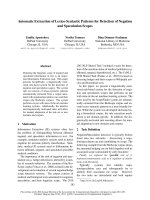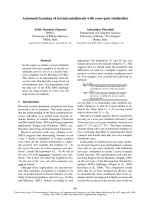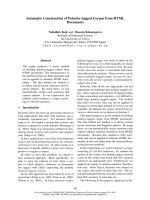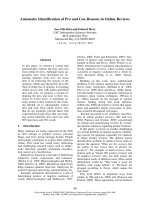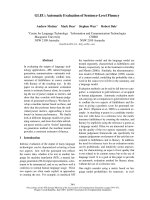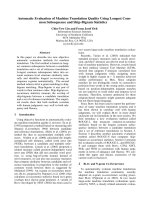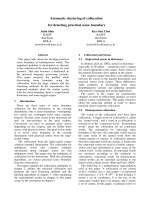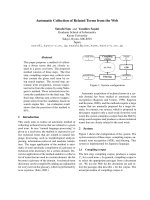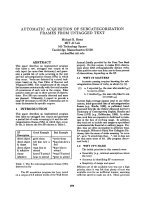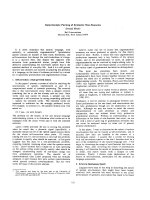Báo cáo khoa học: "Automatic Measurement of Syntactic Development in Child Language" docx
Bạn đang xem bản rút gọn của tài liệu. Xem và tải ngay bản đầy đủ của tài liệu tại đây (82.85 KB, 8 trang )
Proceedings of the 43rd Annual Meeting of the ACL, pages 197–204,
Ann Arbor, June 2005.
c
2005 Association for Computational Linguistics
Automatic Measurement of Syntactic Development in Child Language
Kenji Sagae and Alon Lavie
Language Technologies Institute
Carnegie Mellon University
Pittsburgh, PA 15232
{sagae,alavie}@cs.cmu.edu
Brian MacWhinney
Department of Psychology
Carnegie Mellon University
Pittsburgh, PA 15232
Abstract
To facilitate the use of syntactic infor-
mation in the study of child language
acquisition, a coding scheme for Gram-
matical Relations (GRs) in transcripts of
parent-child dialogs has been proposed by
Sagae, MacWhinney and Lavie (2004).
We discuss the use of current NLP tech-
niques to produce the GRs in this an-
notation scheme. By using a statisti-
cal parser (Charniak, 2000) and memory-
based learning tools for classification
(Daelemans et al., 2004), we obtain high
precision and recall of several GRs. We
demonstrate the usefulness of this ap-
proach by performing automatic measure-
ments of syntactic development with the
Index of Productive Syntax (Scarborough,
1990) at similar levels to what child lan-
guage researchers compute manually.
1 Introduction
Automatic syntactic analysis of natural language has
benefited greatly from statistical and corpus-based
approaches in the past decade. The availability of
syntactically annotated data has fueled the develop-
ment of high quality statistical parsers, which have
had a large impact in several areas of human lan-
guage technologies. Similarly, in the study of child
language, the availability of large amounts of elec-
tronically accessible empirical data in the form of
child language transcripts has been shifting much of
the research effort towards a corpus-based mental-
ity. However, child language researchers have only
recently begun to utilize modern NLP techniques
for syntactic analysis. Although it is now common
for researchers to rely on automatic morphosyntactic
analyses of transcripts to obtain part-of-speech and
morphological analyses, their use of syntactic pars-
ing is rare.
Sagae, MacWhinney and Lavie (2004) have
proposed a syntactic annotation scheme for the
CHILDES database (MacWhinney, 2000), which
contains hundreds of megabytes of transcript data
and has been used in over 1,500 studies in child lan-
guage acquisition and developmental language dis-
orders. This annotation scheme focuses on syntactic
structures of particular importance in the study of
child language. In this paper, we describe the use
of existing NLP tools to parse child language tran-
scripts and produce automatically annotated data in
the format of the scheme of Sagae et al. We also
validate the usefulness of the annotation scheme and
our analysis system by applying them towards the
practical task of measuring syntactic development in
children according to the Index of Productive Syn-
tax, or IPSyn (Scarborough, 1990), which requires
syntactic analysis of text and has traditionally been
computed manually. Results obtained with current
NLP technology are close to what is expected of hu-
man performance in IPSyn computations, but there
is still room for improvement.
2 The Index of Productive Syntax (IPSyn)
The Index of Productive Syntax (Scarborough,
1990) is a measure of development of child lan-
guage that provides a numerical score for grammat-
ical complexity. IPSyn was designed for investigat-
ing individual differences in child language acqui-
197
sition, and has been used in numerous studies. It
addresses weaknesses in the widely popular Mean
Length of Utterance measure, or MLU, with respect
to the assessment of development of syntax in chil-
dren. Because it addresses syntactic structures di-
rectly, it has gained popularity in the study of gram-
matical aspects of child language learning in both
research and clinical settings.
After about age 3 (Klee and Fitzgerald, 1985),
MLU starts to reach ceiling and fails to properly dis-
tinguish between children at different levels of syn-
tactic ability. For these purposes, and because of its
higher content validity, IPSyn scores often tells us
more than MLU scores. However, the MLU holds
the advantage of being far easier to compute. Rel-
atively accurate automated methods for computing
the MLU for child language transcripts have been
available for several years (MacWhinney, 2000).
Calculation of IPSyn scores requires a corpus of
100 transcribed child utterances, and the identifica-
tion of 56 specific language structures in each ut-
terance. These structures are counted and used to
compute numeric scores for the corpus in four cat-
egories (noun phrases, verb phrases, questions and
negations, and sentence structures), according to a
fixed score sheet. Each structure in the four cate-
gories receives a score of zero (if the structure was
not found in the corpus), one (if it was found once
in the corpus), or two (if it was found two or more
times). The scores in each category are added, and
the four category scores are added into a final IPSyn
score, ranging from zero to 112.
1
Some of the language structures required in the
computation of IPSyn scores (such as the presence
of auxiliaries or modals) can be recognized with the
use of existing child language analysis tools, such
as the morphological analyzer MOR (MacWhinney,
2000) and the part-of-speech tagger POST (Parisse
and Le Normand, 2000). However, more complex
structures in IPSyn require syntactic analysis that
goes beyond what POS taggers can provide. Exam-
ples of such structures include the presence of an
inverted copula or auxiliary in a wh-question, con-
joined clauses, bitransitive predicates, and fronted
or center-embedded subordinate clauses.
1
See (Scarborough, 1990) for a complete listing of targeted
structures and the IPSyn score sheet used for calculation of
scores.
Sentence (input):
We eat the cheese sandwich
Grammatical Relations (output):
[Leftwall] We eat the cheese sandwich
SUBJ
ROOT OBJ
DET
MOD
Figure 1: Input sentence and output produced by our
system.
3 Automatic Syntactic Analysis of Child
Language Transcripts
A necessary step in the automatic computation of
IPSyn scores is to produce an automatic syntac-
tic analysis of the transcripts being scored. We
have developed a system that parses transcribed
child utterances and identifies grammatical relations
(GRs) according to the CHILDES syntactic annota-
tion scheme (Sagae et al., 2004). This annotation
scheme was designed specifically for child-parent
dialogs, and we have found it suitable for the iden-
tification of the syntactic structures necessary in the
computation of IPSyn.
Our syntactic analysis system takes a sentence
and produces a labeled dependency structure repre-
senting its grammatical relations. An example of the
input and output associated with our system can be
seen in figure 1. The specific GRs identified by the
system are listed in figure 2.
The three main steps in our GR analysis are: text
preprocessing, unlabeled dependency identification,
and dependency labeling. In the following subsec-
tions, we examine each of them in more detail.
3.1 Text Preprocessing
The CHAT transcription system
2
is the format
followed by all transcript data in the CHILDES
database, and it is the input format we use for syn-
tactic analysis. CHAT specifies ways of transcrib-
ing extra-grammatical material such as disfluency,
retracing, and repetition, common in spontaneous
spoken language. Transcripts of child language may
contain a large amount of extra-grammatical mate-
2
/>198
SUBJ, ESUBJ, CSUBJ, XSUBJ
COMP, XCOMP
JCT, CJCT, XJCT
OBJ, OBJ2, IOBJ
PRED, CPRED, XPRED
MOD, CMOD, XMOD
AUX NEG DET QUANT POBJ PTL
CPZR COM INF VOC COORD ROOT
Subject, expletive subject, clausal subject (finite and non−finite) Object, second object, indirect object
Clausal complement (finite and non−finite) Predicative, clausal predicative (finite and non−finite)
Adjunct, clausal adjunct (finite and non−finite) Nominal modifier, clausal nominal modifier (finite and non−finite)
Auxiliary Negation Determiner Quantifier Prepositional object Verb particle
CommunicatorComplementizer Infinitival "to" Vocative Coordinated item Top node
Figure 2: Grammatical relations in the CHILDES syntactic annotation scheme.
rial that falls outside of the scope of the syntactic an-
notation system and our GR identifier, since it is al-
ready clearly marked in CHAT transcripts. By using
the CLAN tools (MacWhinney, 2000), designed to
process transcripts in CHAT format, we remove dis-
fluencies, retracings and repetitions from each sen-
tence. Furthermore, we run each sentence through
the MOR morphological analyzer (MacWhinney,
2000) and the POST part-of-speech tagger (Parisse
and Le Normand, 2000). This results in fairly clean
sentences, accompanied by full morphological and
part-of-speech analyses.
3.2 Unlabeled Dependency Identification
Once we have isolated the text that should be ana-
lyzed in each sentence, we parse it to obtain unla-
beled dependencies. Although we ultimately need
labeled dependencies, our choice to produce unla-
beled structures first (and label them in a later step)
is motivated by available resources. Unlabeled de-
pendencies can be readily obtained by processing
constituent trees, such as those in the Penn Tree-
bank (Marcus et al., 1993), with a set of rules to
determine the lexical heads of constituents. This
lexicalization procedure is commonly used in sta-
tistical parsing (Collins, 1996) and produces a de-
pendency tree. This dependency extraction proce-
dure from constituent trees gives us a straightfor-
ward way to obtain unlabeled dependencies: use an
existing statistical parser (Charniak, 2000) trained
on the Penn Treebank to produce constituent trees,
and extract unlabeled dependencies using the afore-
mentioned head-finding rules.
Our target data (transcribed child language) is
from a very different domain than the one of the data
used to train the statistical parser (the Wall Street
Journal section of the Penn Treebank), but the degra-
dation in the parser’s accuracy is acceptable. An
evaluation using 2,018 words of in-domain manu-
ally annotated dependencies shows that the depen-
dency accuracy of the parser is 90.1% on child lan-
guage transcripts (compared to over 92% on section
23 of the Wall Street Journal portion of the Penn
Treebank). Despite the many differences with re-
spect to the domain of the training data, our domain
features sentences that are much shorter (and there-
fore easier to parse) than those found in Wall Street
Journal articles. The average sentence length varies
from transcript to transcript, because of factors such
as the age and verbal ability of the child, but it is
usually less than 15 words.
3.3 Dependency Labeling
After obtaining unlabeled dependencies as described
above, we proceed to label those dependencies with
the GR labels listed in Figure 2.
Determining the labels of dependencies is in gen-
eral an easier task than finding unlabeled dependen-
cies in text.
3
Using a classifier, we can choose one
of the 30 possible GR labels for each dependency,
given a set of features derived from the dependen-
cies. Although we need manually labeled data to
train the classifier for labeling dependencies, the size
of this training set is far smaller than what would be
necessary to train a parser to find labeled dependen-
3
Klein and Manning (2002) offer an informal argument that
constituent labels are much more easily separable in multidi-
mensional space than constituents/distituents. The same argu-
ment applies to dependencies and their labels.
199
cies in one pass.
We use a corpus of about 5,000 words with man-
ually labeled dependencies to train TiMBL (Daele-
mans et al., 2003), a memory-based learner (set to
use the k-nn algorithm with k=1, and gain ratio
weighing), to classify each dependency with a GR
label. We extract the following features for each de-
pendency:
• The head and dependent words;
• The head and dependent parts-of-speech;
• Whether the dependent comes before or after
the head in the sentence;
• How many words apart the dependent is from
the head;
• The label of the lowest node in the constituent
tree that includes both the head and dependent.
The accuracy of the classifier in labeling depen-
dencies is 91.4% on the same 2,018 words used to
evaluate unlabeled accuracy. There is no intersec-
tion between the 5,000 words used for training and
the 2,018-word test set. Features were tuned on a
separate development set of 582 words.
When we combine the unlabeled dependencies
obtained with the Charniak parser (and head-finding
rules) and the labels obtained with the classifier,
overall labeled dependency accuracy is 86.9%, sig-
nificantly above the results reported (80%) by Sagae
et al. (2004) on very similar data.
Certain frequent and easily identifiable GRs, such
as DET, POBJ, INF, and NEG were identified with
precision and recall above 98%. Among the most
difficult GRs to identify were clausal complements
COMP and XCOMP, which together amount to less
than 4% of the GRs seen the training and test sets.
Table1 shows the precision and recall of GRs of par-
ticular interest.
Although not directly comparable, our results
are in agreement with state-of-the-art results for
other labeled dependency and GR parsers. Nivre
(2004) reports a labeled (GR) dependency accuracy
of 84.4% on modified Penn Treebank data. Briscoe
and Carroll (2002) achieve a 76.5% F-score on a
very rich set of GRs in the more heterogeneous and
challenging Susanne corpus. Lin (1998) evaluates
his MINIPAR system at 83% F-score on identifica-
tion of GRs, also in data from the Susanne corpus
(but using simpler GR set than Briscoe and Carroll).
GR Precision Recall F-score
SUBJ 0.94 0.93 0.93
OBJ 0.83 0.91 0.87
COORD 0.68 0.85 0.75
JCT 0.91 0.82 0.86
MOD 0.79 0.92 0.85
PRED 0.80 0.83 0.81
ROOT 0.91 0.92 0.91
COMP 0.60 0.50 0.54
XCOMP 0.58 0.64 0.61
Table 1: Precision, recall and F-score (harmonic
mean) of selected Grammatical Relations.
4 Automating IPSyn
Calculating IPSyn scores manually is a laborious
process that involves identifying 56 syntactic struc-
tures (or their absence) in a transcript of 100 child
utterances. Currently, researchers work with a par-
tially automated process by using transcripts in elec-
tronic format and spreadsheets. However, the ac-
tual identification of syntactic structures, which ac-
counts for most of the time spent on calculating IP-
Syn scores, still has to be done manually.
By using part-of-speech and morphological anal-
ysis tools, it is possible to narrow down the num-
ber of sentences where certain structures may be
found. The search for such sentences involves pat-
terns of words and parts-of-speech (POS). Some
structures, such as the presence of determiner-noun
or determiner-adjective-noun sequences, can be eas-
ily identified through the use of simple patterns.
Other structures, such as front or center-embedded
clauses, pose a greater challenge. Not only are pat-
terns for such structures difficult to craft, they are
also usually inaccurate. Patterns that are too gen-
eral result in too many sentences to be manually ex-
amined, but more restrictive patterns may miss sen-
tences where the structures are present, making their
identification highly unlikely. Without more syntac-
tic analysis, automatic searching for structures in IP-
Syn is limited, and computation of IPSyn scores still
requires a great deal of manual inspection.
Long, Fey and Channell (2004) have developed
a software package, Computerized Profiling (CP),
for child language study, which includes a (mostly)
200
automated computation of IPSyn.
4
CP is an exten-
sively developed example of what can be achieved
using only POS and morphological analysis. It does
well on identifying items in IPSyn categories that
do not require deeper syntactic analysis. However,
the accuracy of overall scores is not high enough to
be considered reliable in practical usage, in particu-
lar for older children, whose utterances are longer
and more sophisticated syntactically. In practice,
researchers usually employ CP as a first pass, and
manually correct the automatic output. Section 5
presents an evaluation of the CP version of IPSyn.
Syntactic analysis of transcripts as described in
section 3 allows us to go a step further, fully au-
tomating IPSyn computations and obtaining a level
of reliability comparable to that of human scoring.
The ability to search for both grammatical relations
and parts-of-speech makes searching both easier and
more reliable. As an example, consider the follow-
ing sentences (keeping in mind that there are no ex-
plicit commas in spoken language):
(a) Then [,] he said he ate.
(b) Before [,] he said he ate.
(c) Before he ate [,] he ran.
Sentences (a) and (b) are similar, but (c) is dif-
ferent. If we were looking for a fronted subordinate
clause, only (c) would be a match. However, each
one of the sentences has an identical part-speech-
sequence. If this were an isolated situation, we
might attempt to fix it by having tags that explic-
itly mark verbs that take clausal complements, or by
adding lexical constraints to a search over part-of-
speech patterns. However, even by modifying this
simple example slightly, we find more problems:
(d) Before [,] he told the man he was cold.
(e) Before he told the story [,] he was cold.
Once again, sentences (d) and (e) have identical
part-of-speech sequences, but only sentence (e) fea-
tures a fronted subordinate clause. These limited toy
examples only scratch the surface of the difficulties
in identifying syntactic structures without syntactic
4
Although CP requires that a few decisions be made man-
ually, such as the disambiguation of the lexical item “’s” as
copula vs. genitive case marker, and the definition of sentence
breaks for long utterances, the computation of IPSyn scores is
automated to a large extent.
analysis beyond part-of-speech and morphological
tagging. In these sentences, searching with GRs
is easy: we simply find a GR of clausal type (e.g.
CJCT, COMP, CMOD, etc) where the dependent is
to the left of its head.
For illustration purposes of how searching for
structures in IPSyn is done with GRs, let us look
at how to find other IPSyn structures
5
:
• Wh-embedded clauses: search for wh-words
whose head, or transitive head (its head’s head,
or head’s head’s head ) is a dependent in
GR of types [XC]SUBJ, [XC]PRED, [XC]JCT,
[XC]MOD, COMP or XCOMP;
• Relative clauses: search for a CMOD where the
dependent is to the right of the head;
• Bitransitive predicate: search for a word that is
a head of both OBJ and OBJ2 relations.
Although there is still room for under- and over-
generalization with search patterns involving GRs,
finding appropriate ways to search is often made
trivial, or at least much more simple and reliable
than searching without GRs. An evaluation of our
automated version of IPSyn, which searches for IP-
Syn structures using POS, morphology and GR in-
formation, and a comparison to the CP implemen-
tation, which uses only POS and morphology infor-
mation, is presented in section 5.
5 Evaluation
We evaluate our implementation of IPSyn in two
ways. The first is Point Difference, which is cal-
culated by taking the (unsigned) difference between
scores obtained manually and automatically. The
point difference is of great practical value, since
it shows exactly how close automatically produced
scores are to manually produced scores. The second
is Point-to-Point Accuracy, which reflects the overall
reliability over each individual scoring decision in
the computation of IPSyn scores. It is calculated by
counting how many decisions (identification of pres-
ence/absence of language structures in the transcript
being scored) were made correctly, and dividing that
5
More detailed descriptions and examples of each structure
are found in (Scarborough, 1990), and are omitted here for
space considerations, since the short descriptions are fairly self-
explanatory.
201
number by the total number of decisions. The point-
to-point measure is commonly used for assessing the
inter-rater reliability of metrics such as the IPSyn. In
our case, it allows us to establish the reliability of au-
tomatically computed scores against human scoring.
5.1 Test Data
We obtained two sets of transcripts with correspond-
ing IPSyn scoring (total scores, and each individual
decision) from two different child language research
groups. The first set (A) contains 20 transcripts of
children of ages ranging between two and three. The
second set (B) contains 25 transcripts of children of
ages ranging between eight and nine.
Each transcript in set A was scored fully manu-
ally. Researchers looked for each language structure
in the IPSyn scoring guide, and recorded its pres-
ence in a spreadsheet. In set B, scoring was done
in a two-stage process. In the first stage, each tran-
script was scored automatically by CP. In the second
stage, researchers checked each automatic decision
made by CP, and corrected any errors manually.
Two transcripts in each set were held out for de-
velopment and debugging. The final test sets con-
tained: (A) 18 transcripts with a total of 11,704
words and a mean length of utterance of 2.9, and
(B) 23 transcripts with a total of 40,819 words and a
mean length of utterance of 7.0.
5.2 Results
Scores computed automatically from transcripts
parsed as described in section 3 were very close
to the scores computed manually. Table 2 shows a
summary of the results, according to our two eval-
uation metrics. Our system is labeled as GR, and
manually computed scores are labeled as HUMAN.
For comparison purposes, we also show the results
of running Long et al.’s automated version of IPSyn,
labeled as CP, on the same transcripts.
Point Difference
The average (absolute) point difference between au-
tomatically computed scores (GR) and manually
computed scores (HUMAN) was 3.3 (the range of
HUMAN scores on the data was 21-91). There was
no clear trend on whether the difference was posi-
tive or negative. In some cases, the automated scores
were higher, in other cases lower. The minimum dif-
System Avg. Pt. Difference Point-to-Point
to HUMAN Reliability
GR (Total) 3.3 92.8%
CP (Total) 8.3 85.4%
GR (Set A) 3.7 92.5%
CP (Set A) 6.2 86.2%
GR (Set B) 2.9 93.0%
CP (Set B) 10.2 84.8%
Table 2: Summary of evaluation results. GR is our
implementation of IPSyn based on grammatical re-
lations, CP is Long et al.’s (2004) implementation of
IPSyn, and HUMAN is manual scoring.
Histogram of Point Differences
(3 point bins)
0
10
20
30
40
50
60
3 6 9 12 15 18 21
Point Difference
Frequency (%)
GR
CP
Figure 3: Histogram of point differences between
HUMAN scores and GR (black), and CP (white).
ference was zero, and the maximum difference was
12. Only two scores differed by 10 or more, and 17
scores differed by two or less. The average point dif-
ference between HUMAN and the scores obtained
with Long et al.’s CP was 8.3. The minimum was
zero and the maximum was 21. Sixteen scores dif-
fered by 10 or more, and six scores differed by 2 or
less. Figure 3 shows the point differences between
GR and HUMAN, and CP and HUMAN.
It is interesting to note that the average point dif-
ferences between GR and HUMAN were similar on
sets A and B (3.7 and 2.9, respectively). Despite the
difference in age ranges, the two averages were less
than one point apart. On the other hand, the average
difference between CP and HUMAN was 6.2 on set
A, and 10.2 on set B. The larger difference reflects
CP’s difficulty in scoring transcripts of older chil-
dren, whose sentences are more syntactically com-
plex, using only POS analysis.
202
Point-to-Point Accuracy
In the original IPSyn reliability study (Scarborough,
1990), point-to-point measurements using 75 tran-
scripts showed the mean inter-rater agreement for
IPSyn among human scorers at 94%, with a min-
imum agreement of 90% of all decisions within a
transcript. The lowest agreement between HUMAN
and GR scoring for decisions within a transcript was
88.5%, with a mean of 92.8% over the 41 transcripts
used in our evaluation. Although comparisons of
agreement figures obtained with different sets of
transcripts are somewhat coarse-grained, given the
variations within children, human scorers and tran-
script quality, our results are very satisfactory. For
direct comparison purposes using the same data, the
mean point-to-point accuracy of CP was 85.4% (a
relative increase of about 100% in error).
In their separate evaluation of CP, using 30 sam-
ples of typically developing children, Long and
Channell (2001) found a 90.7% point-to-point ac-
curacy between fully automatic and manually cor-
rected IPSyn scores.
6
However, Long and Channell
compared only CP output with manually corrected
CP output, while our set A was manually scored
from scratch. Furthermore, our set B contained
only transcripts from significantly older children (as
in our evaluation, Long and Channell observed de-
creased accuracy of CP’s IPSyn with more com-
plex language usage). These differences, and the
expected variation from using different transcripts
from different sources, account for the difference in
our results and Long and Channell’s.
5.3 Error Analysis
Although the overall accuracy of our automatically
computed scores is in large part comparable to man-
ual IPSyn scoring (and significantly better than the
only option currently available for automatic scor-
ing), our system suffers from visible deficiencies in
the identification of certain structures within IPSyn.
Four of the 56 structures in IPSyn account for al-
most half of the number of errors made by our sys-
tem. Table 3 lists these IPSyn items, with their re-
spective percentages of the total number of errors.
6
Long and Channell’s evaluation also included samples
from children with language disorders. Their 30 samples of
typically developing children (with a mean age of 5) are more
directly comparable to the data used in our evaluation.
IPSyn item Error
S11 (propositional complement) 16.9%
V15 (copula, modal or aux for 12.3%
emphasis or ellipsis)
S16 (relative clause) 10.6%
S14 (bitransitive predicate) 5.8%
Table 3: IPSyn structures where errors occur most
frequently, and their percentages of the total number
of errors over 41 transcripts.
Errors in items S11 (propositional complements),
S16 (relative clauses), and S14 (bitransitive predi-
cates) are caused by erroneous syntactic analyses.
For an example of how GR assignments affect IP-
Syn scoring, let us consider item S11. Searching for
the relation COMP is a crucial part in finding propo-
sitional complements. However, COMP is one of
the GRs that can be identified the least reliably in
our set (precision of 0.6 and recall of 0.5, see table
1). As described in section 2, IPSyn requires that
we credit zero points to item S11 for no occurrences
of propositional complements, one point for a single
occurrence, and two points for two or more occur-
rences. If there are several COMPs in the transcript,
we should find about half of them (plus others, in
error), and correctly arrive at a credit of two points.
However, if there are very few or none, our count is
likely to be incorrect.
Most errors in item V15 (emphasis or ellipsis)
were caused not by incorrect GR assignments, but
by imperfect search patterns. The searching failed to
account for a number of configurations of GRs, POS
tags and words that indicate that emphasis or ellip-
sis exists. This reveals another general source of er-
ror in our IPSyn implementation: the search patterns
that use GR analyzed text to make the actual IP-
Syn scoring decisions. Although our patterns are far
more reliable than what we could expect from POS
tags and words alone, these are still hand-crafted
rules that need to be debugged and perfected over
time. This was the first evaluation of our system,
and only a handful of transcripts were used during
development. We expect that once child language
researchers have had the opportunity to use the sys-
tem in practical settings, their feedback will allow us
to refine the search patterns at a more rapid pace.
203
6 Conclusion and Future Work
We have presented an automatic way to annotate
transcripts of child language with the CHILDES
syntactic annotation scheme. By using existing re-
sources and a small amount of annotated data, we
achieved state-of-the-art accuracy levels.
GR identification was then used to automate the
computation of IPSyn scores to measure grammati-
cal development in children. The reliability of our
automatic IPSyn was very close to the inter-rater re-
liability among human scorers, and far higher than
that of the only other computational implementation
of IPSyn. This demonstrates the value of automatic
GR assignment to child language research.
From the analysis in section 5.3, it is clear that the
identification of certain GRs needs to be made more
accurately. We intend to annotate more in-domain
training data for GR labeling, and we are currently
investigating the use of other applicable GR parsing
techniques.
Finally, IPSyn score calculation could be made
more accurate with the knowledge of the expected
levels of precision and recall of automatic assign-
ment of specific GRs. It is our intuition that in a
number of cases it would be preferable to trade re-
call for precision. We are currently working on a
framework for soft-labeling of GRs, which will al-
low us to manipulate the precision/recall trade-off
as discussed in (Carroll and Briscoe, 2002).
Acknowledgments
This work was supported in part by the National Sci-
ence Foundation under grant IIS-0414630.
References
Edward J. Briscoe and John A. Carroll. 2002. Robust ac-
curate statistical annotation of general text. Proceed-
ings of the 3rd International Conference on Language
Resources and Evaluation, (pp. 1499–1504). Las Pal-
mas, Gran Canaria.
John A. Carroll and Edward J. Briscoe. 2002. High pre-
cision extraction of grammatical relations. Proceed-
ings of the 19th International Conference on Compu-
tational Linguistics, (pp. 134-140). Taipei, Taiwan.
Eugene Charniak. 2000. A maximum-entropy-inspired
parser. In Proceedings of the First Annual Meeting
of the North American Chapter of the Association for
Computational Linguistics. Seattle, WA.
Michael Collins. 1996. A new statistical parser based on
bigram lexical dependencies. Proceedings of the 34th
Meeting of the Association for Computational Linguis-
tics (pp. 184-191). Santa Cruz, CA.
Walter Daelemans, Jacub Zavrel, Ko van der Sloot, and
Antal van den Bosch. 2004. TiMBL: Tilburg Memory
Based Learner, version 5.1, Reference Guide. ILK Re-
search Group Technical Report Series no. 04-02, 2004.
T. Klee and M. D. Fitzgerald. 1985. The relation be-
tween grammatical development and mean length of
utterance in morphemes. Journal of Child Language,
12, 251-269.
Dan Klein and Christopher D. Manning. 2002. A genera-
tive constituent-context model for improved grammar
induction. Proceedings of the 40th Annual Meeting
of the Association for Computational Linguistics (pp.
128-135).
Dekang Lin. 1998. Dependency-based evaluation of
MINIPAR. In Proceedings of the Workshop on the
Evaluation of Parsing Systems. Granada, Spain.
Steve H. Long and Ron W. Channell. 2001. Accuracy of
four language analysis procedures performed automat-
ically. American Journal of Speech-Language Pathol-
ogy, 10(2).
Steven H. Long, Marc E. Fey, and Ron W. Channell.
2004. Computerized Profiling (Version 9.6.0). Cleve-
land, OH: Case Western Reserve University.
Brian MacWhinney. 2000. The CHILDES Project: Tools
for Analyzing Talk. Mahwah, NJ: Lawrence Erlbaum
Associates.
Mitchel P. Marcus, Beatrice Santorini, and Mary Ann
Marcinkiewics. 1993. Building a large annotated cor-
pus of English: The Penn Treebank. Computational
Linguistics, 19.
Joakim Nivre and Mario Scholz. 2004. Deterministic de-
pendency parsing of English text. Proceedings of In-
ternational Conference on Computational Linguistics
(pp. 64-70). Geneva, Switzerland.
Christophe Parisse and Marie-Thrse Le Normand. 2000.
Automatic disambiguation of the morphosyntax in
spoken language corpora. Behavior Research Meth-
ods, Instruments, and Computers, 32, 468-481.
Kenji Sagae, Alon Lavie, and Brian MacWhinney. 2004.
Adding Syntactic annotations to transcripts of parent-
child dialogs. Proceedings of the Fourth International
Conference on Language Resources and Evaluation
(LREC 2004). Lisbon, Portugal.
Hollis S. Scarborough. 1990. Index of Productive Syn-
tax. In Applied Psycholinguistics, 11, 1-22.
204
